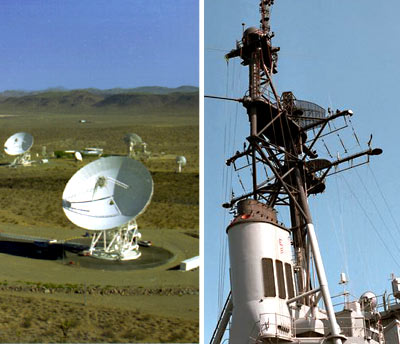We have seen that the echo of a sound can be used to determine how far away something is, and we have also seen that we can use the Doppler shift of the echo to determine how fast something is going. It is therefore possible to create a "sound radar," and that is exactly what sonar is. Submarines and boats use sonar all the time. You could use the same principles with sound in the air, but sound in the air has a couple of problems:
- Sound doesn't travel very far -- maybe a mile at the most.
- Almost everyone can hear sounds, so a "sound radar" would definitely disturb the neighbors (you can eliminate most of this problem by using ultrasound instead of audible sound).
- Because the echo of the sound would be very faint, it is likely that it would be hard to detect.
Radar therefore uses radio waves instead of sound. Radio waves travel far, are invisible to humans and are easy to detect even when they are faint.
Let's take a typical radar set designed to detect airplanes in flight. The radar set turns on its transmitter and shoots out a short, high-intensity burst of high-frequency radio waves. The burst might last a microsecond. The radar set then turns off its transmitter, turns on its receiver and listens for an echo. The radar set measures the time it takes for the echo to arrive, as well as the Doppler shift of the echo. Radio waves travel at the speed of light, roughly 1,000 feet per microsecond; so if the radar set has a good high-speed clock, it can measure the distance of the airplane very accurately. Using special signal processing equipment, the radar set can also measure the Doppler shift very accurately and determine the speed of the airplane.
In ground-based radar, there's a lot more potential interference than in air-based radar. When a police radar shoots out a pulse, it echoes off of all sorts of objects -- fences, bridges, mountains, buildings. The easiest way to remove all of this sort of clutter is to filter it out by recognizing that it is not Doppler-shifted. A police radar looks only for Doppler-shifted signals, and because the radar beam is tightly focused it hits only one car.
Police are now using a laser technique to measure the speed of cars. This technique is called lidar, and it uses light instead of radio waves. See How Radar Detectors Work for information on lidar technology.

Left: Antennas at Goldstone Deep Space Communications Complex (part of NASA's Deep Space Network) help provide radio communications for NASA's interplanetary spacecraft. Right: Surface search radar and air search radar are mounted on the foremast of a guided missile destroyer.


